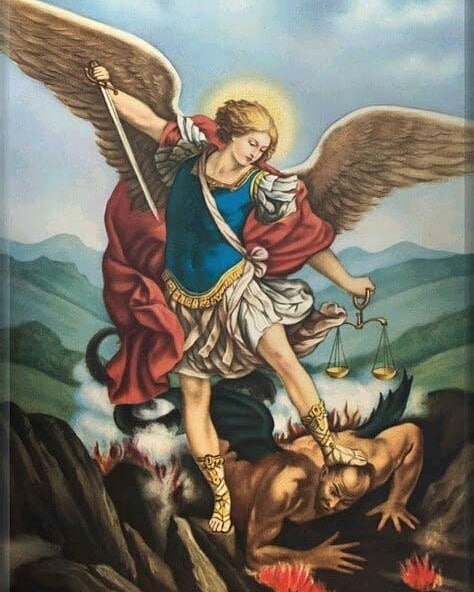We are familiar with this invocation from the Lord’s prayer. It is also the major theme of an encyclical by St Pope Paul VI in 1975. Paul VI says: “What are the Church’s greatest needs at the present time? Don’t be surprised at our answer and don’t write it off as simplistic or even superstitious: one of the Church’s greatest needs is to be defended against the evil we call the Devil”. On another occasion he candidly admitted that ‘from some fissure the smoke of Satan has entered into the temple of God’.
St. Paul calls Satan the ‘god of this world,’ and advises us to ‘put on the whole armor of God, so that we may be able to stand against the wiles of the devil’. ‘For our struggle is not against enemies of flesh and blood, but against the rulers, against the authorities, against the cosmic powers of this present darkness, against the spiritual forces of evil in the heavenly places’ (Eph 6: 11-12). If Satan, the god of this world is successful in infiltrating the Church through some fissure, it calls for greater vigil and prayer from the Church to ward it off.
This is an article about the dark entity called Satan who always places himself as an obstacle to the fulfilment of God’s plan for humanity. He is the arch-enemy of God and by extension God’s children too. He is powerless against God, but can do a great lot of harm to us mortals.
Often we see people doubting the very existence of Satan. This is the biggest deception Satan employs on men. He wants to hide his real self and operate from behind. Like an artful thief, he gives the impression that he doesn’t exist. If we do not believe in his existence, it is easy for him to execute his plans. As for his victims, since they do not acknowledge his existence, they fail in taking the necessary precautions and the result is that they easily fall into his snares.
The Gospel tells us that we are dealing with not just one Devil, but with many (Lk. 11:21, Mk 5:9) the principal one being Satan, which means the adversary, the enemy. He has his cohorts to get things done according to his plans. It is a whole mysterious world, where a most unfortunate drama is being played out without us ever knowing anything about it, but as victims destined to face its earthly manifestations in our daily life.
Nowadays, it has become fashionable to depict the devil as something – not someone- that symbolises evil. They try to convince us that Satan is a non- entity, rather it is the collective name used to refer to the forces of evil which are innate or engraved in human nature. With such a simplistic view about one of the cardinal themes of our relation with God, we are surely risking our eternal life.
So let us start from the basics. There is an entity called Satan. It is not a mere idea, but the personification of all evil. The Church teaches that he was originally created as a beautiful angel but later was thrown out of heaven for his unwillingness to submit himself to the Almighty God. The Scripture gives us innumerable instances where the Holy Spirit talks about the dark force of evil as personified in Satan. We know and believe that ‘all Scripture is inspired by God’ (2 Tim 3:16). If that is the case, the true author of the Bible is the Holy Spirit. It means the Bible is a single book with seventy three parts, starting from Genesis and concluding with Revelation. Like any other book, we need to read the introduction of the Bible to get a brief idea about its contents. And how the author summarises its theme is described in its conclusion.
The first three chapters of the Book of Genesis can be treated as an introduction to the BIble. Here we see creation of the universe in the first chapter. In the second chapter we read about the Garden of Eden, the epitome of the state of bliss that God had gifted to man. In the third chapter we find another character entering this sacred place and defiling its inmates by sheer lies. He was the serpent, another name given to Satan. We read: ‘Now the serpent was more crafty than any other wild animal that the Lord God made’ (Gen 3:1). The one and only enmity that God had created is between ‘the serpent and the woman, and between his offspring and hers’ (Gen 3:15). As for the offspring of the woman, God intended that he should strike the head of the serpent, even though the serpent would strike his heel.
Starting with this introduction, the Bible progresses by describing the step by step fulfilment of God’s plan to redeem His children from the poison with which Satan afflicted them. Throughout the Bible we can see the unceasing enmity between God’s people and God’s enemies. In fact the Bible is the history of the great battle between God and Satan where God’s victory is predestined.
Just like the first three chapters serving as an introduction to this great book, its last three chapters can be described as its conclusion. In Revelation 20:2-3, we read about an angel seizing the ‘dragon, the ancient serpent, who is the Devil and Satan’, and binding him for a thousand years, and locking and sealing him in a pit. Then we read about the ultimate defeat of Satan. ‘And the devil who had deceived them was thrown into the lake of fire and sulfur, where the beast and the false prophet were, and they will be tormented day and night for ever and ever’ (Rev.20:10). This is the retribution given to Satan who once deceived man to disobey God, his creator and since then has been tempting him to repeat the same sin every time, everywhere.
In ch. 21 of the Book of Revelation, we are introduced to the New Heaven and the New Earth. The Old dwelling of man, the Garden of Eden was defiled by sin and only a complete renovation could make it inhabitable again for the new man who was redeemed by the precious blood of Jesus Christ. In the Garden of Eden, God walked with Adam and Eve. About the New Jerusalem it is written; ‘See, the home of God is among mortals. He will dwell with them as their God, they will be his peoples, and God himself will be with them’ (Rev 21:3). As far as Satan is concerned, this New Jerusalem is inviolable, because it is written; ‘Nothing unclean will enter it, nor anyone who practices abomination or falsehood, but only those who are written in the Lamb’s book of life’ (Rev 21.27). Satan being the personification for falsehood and abomination, cannot enter the New Jerusalem that God had designed for His beloved children. In the Garden of Eden, there were surely some loopholes – or some fissure- that made the entry of Satan possible. In the New City of God, these loopholes too are plugged, meaning Satan has been debarred from this holy place for all eternity. Henceforth he cannot deceive its inmates. This is the way in which our God restores the original splendor, glory and beauty of His creation.
Coming to the final chapter of the Bible, it describes the river of the water of life, bright as crystal. The tree of life is also depicted with its twelve kinds of fruits and its leaves given for the healing of the nations. This is the very same tree of life that was forbidden to man when he was thrown out of the Garden of Eden. With the presentation of the New Heaven and the New Earth for the elect, comes the end of history as we know it. God wins decisively and the ‘dragon, the ancient serpent, who is the Devil and Satan’ and his associates go down wailing and gnashing their teeth at the thought of the eternal bliss of the elect to which they will never be admitted.
We cannot study the Bible, nor can we claim to be practising Christians, unless we give due importance to the concept of Satan as a person, rather than as an idea or symbol. Being a liar and father of lies, Satan takes pleasure in denying his own existence. On the other hand our God introduced himself as ‘ I AM WHO I AM’ to Moses. Often our God repeats that He is the God of Abraham, the God of Issac, and the God of Jacob. On the other hand, what Satan tells us through his minions and false prophets is that he is one who does not exist!
The Church is deeply concerned about the Devil and the influence he can exert on individuals as well as on communities, or events. Unfortunately it is given little attention these days. Whenever somebody under demonic influence or demonic possession is presented, the general tendency is to view it from a psychoanalytic or psychiatric angle. One who fails in diagnosis is sure to fail in treatment also. One who fails to diagnose the demonic influence in a person cannot help him out of it.
The Church has no doubt that if there is a kingdom of God, there definitely should be a kingdom of Satan as well. The battle in which the Church is engaged from day one and which should continue through the last day, is nothing but delivering the souls of men from the clutches of Satan. The Catechism of the Catholic Church teaches: ‘The power of Satan is, nonetheless, not infinite. He is only a creature, powerful from the fact that he is pure spirit, but still a creature. He cannot prevent the building up of God’s reign. Although Satan may act in the world out of hatred for God and his kingdom in Christ Jesus, and although his action may cause grave injuries – of a spiritual nature and, indirectly, even of a physical nature- to each man and to society, the action is permitted by divine providence which, with strength and gentleness guides human and cosmic history. It is a great mystery that providence should permit diabolical activity, but we know that in everything God works for good with those who love him’ (CCC 395).
It is in the fitness of things that being conscious about the existence of Satan and the ways in which he attacks us, the Church has instituted the ministry of deliverance and entrusted it to anointed priests, who in communion with the apostolic authority of the Church carry on this vital ministry. Ideally there should be at least one priest in every diocese specially authorised by the bishop to perform exorcism and carry out the ministry of deliverance. Again, we should admit that this is one area grossly neglected in practice, though there is no dearth of teachings in the Church doctrines.
Any meaningful discussion about the ministry of deliverance should start from what Jesus Christ, the one anointed to strike the head of the serpent, did on earth. We read that Jesus cast out demons from a number of persons and in one case we read that the person was possessed by not one, but a legion of evil spirits. On another occasion Jesus tells about the possibilities of an unclean spirit once gone out of a person returning with seven other spirits more evil than itself and making the person’s last state worse than the first. What we gather from these incidents is that evil spirits have separate identities and they can be numbered. The Bible is inviting an unbelieving generation to understand that Satan is a person and his associates are many, with distinct identities. And the Church is inviting the faithful to make use of the valuable treasury of power and anointing given to it by God to ward off demonic influences and to cast out demons from them. Blessed are those who respond to this call and get delivered from evil, rather than continuing under the influence of the vilest enemy of mankind, without ever knowing the pitiful state in which they are.
How did Jesus cast out demons? We get the answer from the gospel of Mathew. ‘But if it is by the Spirit of God that I cast out demons, then the kingdom of God has come to you’ (Mt 12:28). Though it was the Holy Spirit that did the actual work of exorcism, Jesus had indeed prepared himself for this important ministry. It is no wonder that the Holy Spirit led Jesus straight to the wilderness after his baptism in Jordan. We know that Jesus was full of Spirit after baptism, but he was not allowed to commence his preaching ministry immediately. God the Father willed that his beloved son should conquer the devil as a precondition to be sent on the mission of evangelization.
While in the wilderness, Jesus did only two things. He spent those forty days fasting and praying. This preparation helped Jesus to face the devil head on. Devil’s craftly framed temptations were not enough to overpower Jesus. He replied to Satan in three simple sentences. Though simple, they were powerful, because they were the words of God.
Exorcism is an important ministry assigned by Jesus to his disciples. They were given the power to cast out demons by using the name of Jesus. Mathew and Luke mention that the disciples were given power and authority over all demons when they were sent to preach. Mark mentions this along with the parting message of Jesus before ascension.
Now we are coming to the most crucial point. Do exorcisms happen these days? The answer is yes and no because it depends on the place and person. As we know, every priest is given the power to cast out demons. But not everyone uses it. Even among those who are specifically entrusted with this duty by their bishops some shy away from venturing into it, perhaps due to the fear of the unknown. But for this, they are familiar with every other kind of priestly ministries as they are related to either God or man. But this thing called deliverance is connected to the devil, who is invisible, though not invincible. Second reason is that an exorcism or attempt to cast out demons demands a high level of personal sanctity from the celebrant. The priest who does exorcism should also be a man of prayer. It is a settled fact that faith and holiness of the celebrant are the most crucial factors affecting the outcome of a deliverance service. If Jesus cast out demons in a particular way we should also use the same way. It is prayer, fasting, and seeking the help of the Holy Spirit. When a priest so equipped says the words of deliverance in the name of Jesus Christ, the Devil has to flee. He cannot stand before the word of God. He will leave the person whom he possessed till then.
Many priests from different countries take exorcism seriously and devote their time in its performance, thereby helping people overcome diabolical infestations and demonic possessions. Among exorcists the name of Fr Gabriele Amorth should never be missed. He was the official exorcist of the Catholic Church. The International Association of Exorcists (IAE), was founded in Italy in 1991 by Father Gabriele Amorth (1925-2016) and Father René Chenessau, who was exorcist for the diocese of Pontoise (Paris). Now IAE is the umbrella organisation of exorcists from across the globe. The association regularly conducts training courses and international conferences with a view to share ideas among exorcists and also to bring more and more priests to this field. It is a sad fact that while diabolical infestations and satanic attacks are on the rise, the number of priests performing exorcism is on the wane.
Works of the devil in a person can be manifested in many ways. They include diabolical possession, diabolical vexation (physical or psychological attacks by a demon), disturbances or hallucinations initiated by a demon and demonic infestation (demonic disturbances inflicted on houses, objects or animals). Of these, satanic possession is the gravest but rare in number when compared to other demonic attacks.
It should not be difficult to find a priest performing exorcism in your diocese. In case of difficulty, you can always contact the diocesan centre to know the name of the priest who is officially assigned with this ministry and approach him. Apart from that you can also avail the services of Catholic Retreat Centres. Many such centres were conducting special prayers and deliverance services on a regular basis till the onslaught of Covid-19 placed restrictions on religious services and gatherings. Nevertheless you can contact them over telephone or email and seek their guidance. You can also attend online retreats, where deliverance prayer is an integral part.
We started with a reference to the Lord’s prayer. It is one of the best deliverance prayers that can be used by any person at any time. Prayer is one thing Satan fears the most. When we ask our Father to deliver us from evil, the devil has no doubt that this prayer will be answered. Similarly when we recite the Creed, Satan knows that we are re-affirming our faith in the Almighty God, who through his son saved the world. Many of the priests recommend the repeated recital of the Creed during deliverance services. Another simple but effective prayer is ‘Hail Mary’. The devil knows that the ‘Woman’ will crush his head one day. Every time he hears the name of Mary from the lips of her children, the devil flees from them. Simply reciting the word of God is another effective weapon to cast out demons, because Jesus defeated the devil using the Word.
There are many other prayers that could be used against satanic infestations and demonic attacks. Of them the prayer to Michael the Archangel occupies an important place. This prayer was written by Pope Leo XIII after he was permitted to have a vision of Archangel Michael coming to the help of God’s children when demonic forces started attacking the Church. The prayer in its original form is lengthy. However a shorter form as given below was prescribed to be said everyday after Holy Mass which practice was abruptly and without any valid reason, stopped during the 1960s.
‘Saint Michael the Archangel, defend us in battle, be our protection against the malice and snares of the devil. May God rebuke him we humbly pray; and do thou, O Prince of the Heavenly host, by the power of God, thrust into hell Satan and all evil spirits who wander through the world for the ruin of souls. Amen’.
After a century has passed since the vision of Leo XIII, Pope John Paul II reaffirmed the need to seek the help of St Michael in our battle against the devil in these words: “The battle against the devil, which is the principal task of Saint Michael the Archangel, is still being fought today, because the devil is still alive and active in the world.”
In a world where we have to face the devil who is ‘still alive and active’ we should be alive to this truth and actively work for casting out satanic influences from our life. In the present context, being active means taking up the whole armor of God and resisting the devil. Let us make use of the avenues of deliverance services granted to us through the apostolic anointing of the Holy Church.
Let us pray: Lord, deliver us from evil.

















